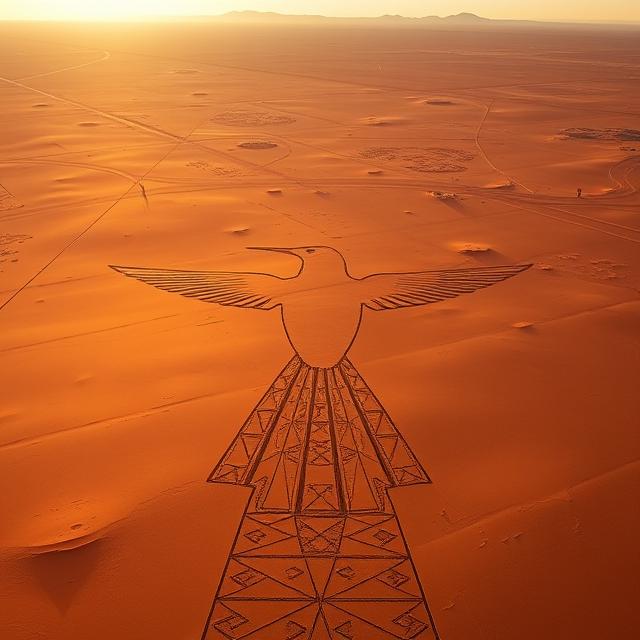Stretching across the bone-dry, sun-scorched plains of southern Peru lies one of the world’s most profound and enduring enigmas: the Nazca Lines. These colossal geoglyphs, etched into the desert floor over 1,500 years ago, depict everything from simple geometric shapes and spirals to stunningly complex figures of animals, birds, and insects. Visible in their entirety only from the sky, these massive drawings have fueled decades of speculation, inspiring awe and wonder while posing a fundamental question: for whom were these messages intended? Were they, as some have suggested, giant runways for ancient astronauts, or do they represent a form of cosmic graffiti, a sacred text written on the very fabric of the earth?
The Nazca Lines are a vast collection of hundreds of individual figures, ranging in complexity from simple lines that run for miles with perfect precision to intricate representations of hummingbirds, spiders, monkeys, sharks, and lizards. Carved into the reddish-black desert pavement, known as “pampa,” the designs were created by the Nazca people, a culture that flourished in the region between 100 BCE and 800 CE. The method of their creation was deceptively simple: the Nazca people removed the top layer of rust-colored pebbles and rock to expose the lighter-colored, sandy soil beneath. In this arid, windless climate, one of the driest places on Earth, these shallow trenches have been miraculously preserved for centuries.
The sheer scale of the geoglyphs is staggering. The famous hummingbird measures over 300 feet long, the spider is about 150 feet across, and the condor has a wingspan of over 440 feet. The figures are so large that they are impossible to fully appreciate from ground level, a fact that has given rise to the most tantalizing and persistent theories about their purpose. If their creators could not see them, then who could?
Mainstream Archaeology: A Tapestry of Ritual and Water
Modern archaeology, eschewing extraterrestrial explanations, has pieced together a compelling, albeit complex, picture of the Nazca Lines’ purpose, deeply rooted in the environment and religious beliefs of their creators. The prevailing theory is that the lines were created for ritualistic purposes, acting as sacred pathways and ceremonial centers.
The Water Cult: The Nazca Plain is an incredibly arid environment, where water is the most precious of all resources. Many archaeologists believe the lines are intrinsically linked to the procurement of water. Researchers have noted that many of the lines, particularly the geometric ones, appear to align with natural water sources, including underground aqueducts known as puquios, which the Nazca people engineered with remarkable skill. The animal figures depicted in the geoglyphs—such as spiders (often associated with rain in ancient cultures), hummingbirds, and monkeys (native to the wetter, Amazonian region)—are also thought to be symbols of fertility and water. According to this theory, the Nazca people would walk along these lines in ceremonial processions, offering prayers and performing rituals to appease the mountain gods who were believed to control the weather and the flow of water, thus ensuring the survival of their agricultural society.
Maria Reiche’s Celestial Calendar: One of the earliest and most dedicated researchers of the Nazca Lines was the German-Peruvian mathematician and archaeologist Maria Reiche. Beginning her work in the 1940s, Reiche spent half a century tirelessly mapping, cleaning, and preserving the geoglyphs. She was the first to propose a comprehensive astronomical theory, suggesting that the lines functioned as a massive celestial calendar. Reiche argued that many of the lines align with the rising and setting of the sun and other important stars during key astronomical events like the solstices. The animal figures, she posited, might represent constellations. While some of her specific astronomical alignments have been disputed by later researchers, her core idea—that the lines had a celestial and calendrical function—remains a significant part of the overall interpretation.
Sacred Pathways and Social Hubs: More recent research, utilizing advanced satellite imagery and drone technology, has expanded on these ideas. Archaeologists now believe the lines served as a kind of social and religious hub for different clans and communities. The various geoglyphs may have been created and maintained by different family groups, who would gather at these sites for important social and ceremonial occasions. Walking the lines was a physical act of prayer, a way to connect with the divine and reinforce social bonds. Evidence of offerings, such as broken pottery and food items, has been found at the intersections of many lines, supporting the theory that they were active ritual sites.
The Fringe Theory: Runways for Ancient Astronauts
While archaeological explanations are grounded in the cultural and environmental context of the Nazca people, a far more sensational theory captured the public imagination in the late 1960s and continues to hold sway in popular culture. This is the “ancient astronaut” theory, most famously promoted by Swiss author Erich von Däniken in his blockbuster book, Chariots of the Gods?.
Von Däniken looked at the Nazca Lines and saw not ritual pathways, but an ancient airfield. He argued that the long, straight lines were runways for alien spacecraft and that the figures were designed as navigational aids or as a tribute to these “gods” from the sky. How else, he reasoned, could such massive and precise figures be created without the ability of flight? Why create images that can only be properly seen from above unless they were meant for celestial visitors?
This theory, while compelling to many, has been thoroughly debunked by the scientific community. Archaeologists point out that the lines are not “runways” in any practical sense; the soft, sandy ground could never support the landing of a heavy aircraft. Furthermore, experiments have shown that a small team of people, using simple tools and basic principles of geometry, could have easily created even the most complex figures. By using wooden stakes and long ropes, the Nazca people could have scaled up small drawings to their monumental proportions with remarkable accuracy. The idea that flight was necessary for their creation is simply not true.
Despite the lack of evidence, the ancient astronaut theory persists, a testament to our fascination with the unknown and the desire for extraordinary explanations for extraordinary phenomena. It speaks to a modern mythology, one where our ancestors were not alone and the gods did indeed come from the stars.
The Enduring Mystery of the Pampa
Today, the Nazca Lines face threats from climate change, erosion, and human encroachment. Squatters and vehicle traffic have caused irreparable damage to some of the ancient figures. In response, Peruvian authorities and international organizations are working to preserve this fragile UNESCO World Heritage site for future generations.
As technology advances, so too does our ability to study these magnificent creations. Drones and satellite mapping continue to reveal new geoglyphs, some predating the Nazca culture itself, suggesting that the tradition of drawing on the desert floor is older than previously thought.
So, were the Nazca Lines runways for the gods or a form of cosmic graffiti? The evidence overwhelmingly points away from ancient astronauts and towards a complex, earth-bound purpose rooted in ritual, astronomy, and a desperate plea for water. They were not messages for beings from another world, but rather a direct line of communication to the powerful deities the Nazca believed controlled their own. They are a testament to human ingenuity, faith, and the profound connection between a people and their environment. The desert floor was their sacred text, the lines their prayers, and the sky, not a landing strip for alien craft, but the home of the gods they hoped were watching.
Want to explore the shadows even deeper? For more chilling cases like this, visit SinisterArchive.com, where the legends are real.




